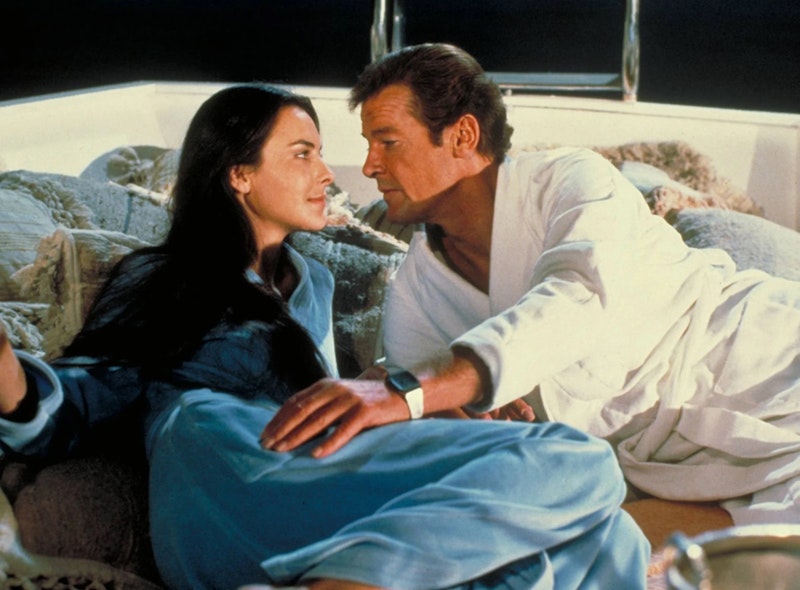Roger Moore thought 1981’s For Your Eyes Only was a highlight of his time playing James Bond, along with The Spy Who Loved Me. I can’t see it. Eyes Only is dull visually and narratively, with a perfunctory theme about the futility of revenge contradicted by almost every moment of every other Bond film—and, the opening sequence of this one.
It’s a peculiar scene in which a mysterious bald figure in a wheelchair (an uncredited John Hollis) tries to kill Bond, fails, and is killed by Bond instead. The man’s Ernst Stavro Blofeld, but is unnamed for legal reasons. Blofeld was already dealt with in Diamonds Are Forever, so there’s no particular sense of closure from this sequence, no plot connection to the story that follows, and no obvious reason for it at all.
The story begins with the accidental sinking of a British sub, followed by the assassination of a part-time British operative trying to locate the wreck. Bond’s ordered to retrieve a high-tech widget from the sub and eliminate the hit-man and his boss, which leads him to an encounter with the dead operative’s daughter Melina (Carole Bouquet), out for revenge. Trying to track down the assassin’s employer leads Bond to Italy and shenanigans with biathletes and ice skaters, then on to Corfu, Albania, and finally an abandoned mountaintop monastery.
The opening section’s reasonably close to the titular short story, but loses a character touch. The story has Bond undertaking an assassination on the implied personal request of his superior M, but Bernard Lee, who had incarnated that grim grey god of MI6 for 11 movies, died just before this film was shot. This became the first Bond film without an M, and the mission a simple order from 007’s superiors.
“For Your Eyes Only” was a short story, the title of a collection of tales, so the film’s bulked out by using the missing-technology MacGuffin to tie in events of “Risico,” another story in the collection, with the climax of the novel Live and Let Die thrown in for good measure. It’s a clever structural approach, credited to veteran Bond scriptwriter Richard Maibaum, assisted by Michael G. Wilson. Wilson’s said Bond stories were worked out by a committee that included the stunt coordinators, which may explain some of the problems that emerge. Maibaum observed that the theme about the futility of revenge gets lost, touched on in the first scenes with Melina and then not again until the very end.
One might also wonder whether that particular theme makes sense in a Bond story, typically fantasies of righteous violence—as in the opening sequence with Blofeld. Structurally the theme leads to odd choices: “Greek women, like Elektra, always avenge their loved ones,” says Melina at one point, which is a hell of a thing to take away from the fall of the House of Atreus and also a weighty reference that does nothing for the film.
John Glen, who’d edited three Bond films, takes the reigns as director here; Peter Lamont, who’d worked on every Bond film since 1964, is production designer. Neither acquit themselves well. The movie’s never interesting to look at, with obvious sets and poor compositions. None of the actors have any chemistry, and Moore’s performance is bland.
Moore, 54 when Eyes Only was released, almost didn’t return to play Bond in this movie, and probably shouldn’t have. He does his best, but is too old for the part and the physical action involved. He doesn’t move like an elite secret agent, and the substitution of stunt men in the action scenes is obvious.
The script even draws attention to his age. There’s a scene where Bond refuses to sleep with a girl (Lynn-Holly Johnson) who’s snuck into his hotel room, and while it’s nice to see a limit to Bond’s libertinism, the girl’s age isn’t stated onscreen. According to Moore, she’s meant to be 16, but Johnson’s 22, a year younger than Carole Bouquet playing Melina. We therefore do not see Bond turning down a high-schooler, but rejecting a youthful but adult woman. And we think: well, he’s too old for her, isn’t he?
If Bond’s less of a sexual creature, the film makes up for that with more action. This may be the first Bond film to really be an action movie as opposed to a thriller with action scenes—the fights and shootouts are more structurally central. Moore aside, most are effective in their staging, execution and build. But they’re too often undercut by goofy comedy. A fight in a hockey rink’s a particular offender, only partially redeemed by exceptional use of a Zamboni.
It’s as though the filmmakers looked at Moonraker and decided to take out the wrong kind of cartooniness. The high-tech world of that film is almost completely absent here, even though the central plot driver is a piece of technology. But there’s no increase in seriousness. Instead the movie’s merely smaller than its predecessor, more trivial.
The movie may be aiming at a more human story, but Moore’s still an archetypal James Bond. Even if the script had given him credible emotional scenes and a character arc, he still plays the part not as a human but an idea: the platonic image of a dashing secret agent. That’s potentially an interesting choice, but it’s out of place here. And the story’s emphasis on action means attempts to bring in more grounded human concerns are simply in the way. Interrupting gun battles with conversations about a teenager’s figure-skating career doesn’t engage the audience either.
The 1980s were a great time for cheap action films. For Your Eyes Only isn’t cheap, with an estimated budget of $28 million, but looks as though it is. If it’s an early example of the 80s action movie, it’s a subpar one. Just as it’s a subpar Bond movie.

